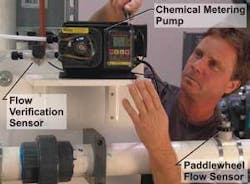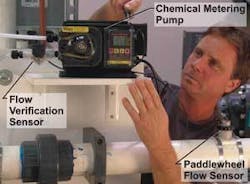Paddlewheel Flowmeters for Use in Proportional Feed Systems
by Bill McDowell
Electronic flowmeters to control metering pumps and other industrial water treatment system components can cost thousands of dollars. While many are extremely accurate and offer a variety of features, many are often underutilized and overqualified for the application.
Excess capability, features and accuracy are often a waste of money. You’ll get the most value on system components that meet demands of the system without overkill. While expensive, high technology solutions may be available for your application, low cost paddlewheel flowmeters offer high accuracy solutions (to +/-1% of the full scale reading) for many industrial water and wastewater treatment applications. They’re easy to install and operate, resulting in relatively low overall cost of ownership.
Industrial water use
Paddlewheel flowmeters can control inexpensive metering pumps used to inject chemicals such as chlorine and acids into water systems. The chemical must be injected at the proper rate to achieve correct water/chemical proportions. In a system with varying water flow rates, solenoid driven metering pumps are often used. These pumps can be “pulsed” by an external controller or PLC resulting in intermittent small injections of chemical per volume of water flow.
These flowmeters also can be used to start and stop inexpensive, motor-driven, fixed-feed rate metering pumps without need for PLCs or other control equipment. When a programmed volume of fluid is measured, control circuitry in the meter turns the chemical pump on and off for a set amount of time. Although this method results in an uneven “pulsed” dispersion of chemical in the system, it’s simple to install and achieves a highly accurate, easy-to-maintain proportional feed system.
In some applications, uneven chemical injection results in untreated portions of a flow stream, especially at very low injection rates. If a finer dispersion of chemical is required, variable speed peristaltic (squeeze tube) metering pumps can be used. A new generation of high pressure peristaltic metering pumps come equipped with variable speed motors and offer continuous chemical injection instead of interrupted “pulsed” injection. These can pump air (eliminating vapor lock and lost prime issues typical of diaphragm pumps in chlorine applications), they can prime against maximum back pressure and dispense the same amount of chemical regardless of changes in system pressure. The pump’s speed can be controlled directly by a paddlewheel sensor’s high-speed frequency signal. Pump speed is programmed to react to changes in frequency output by the flow sensor resulting in highly accurate proportional feed even at low injection rates.
Flow verification
Paddlewheel flowmeters can verify if chemical injection has occurred. Their sensors are capable of measuring chemical metering pump output rates as low as 1 ounce per minute. When installed on the metering pump, the flow sensor can be used to alert the system operator that an error exists in the system. Some metering pumps include electronics that react to the paddlewheel output signal. If the metering pump should fail to inject chemical due to a pump malfunction, clogged fitting, exhausted chemical container, etc., an alarm output is triggered.
Flow rate, range alarms
Paddlewheel flowmeters can monitor system flow rate. When that’s critical, one can be used to alert the system operator if the rate increases or decreases out of a set range. The electronic display can be programmed with a high and low rate amount which will trigger an alarm output signal. The alarm can automatically reset or latch. Trigger and release values can be set, with hysteresis, which will eliminate “flickering” that can occur when flow rate is at the alarm value.
Maintenance
Paddlewheel flowmeters will operate accurately until excessive wear on the paddle or axle causes inaccurate readings, when replacement of the paddle and axle is recommended. A new paddle and axle should bring the meter back into calibration without field calibration.
In rare cases, excessive flow velocity has been known to damage a paddle and axle causing the paddle to fall off into the flow stream. Recent paddlewheel design and construction materials improvements virtually eliminate these problems. When operated within a recommended flow range, the paddle and axle shouldn’t be damaged.
Conclusion
The long history of paddlewheel meters in industrial water treatment applications proves they’re a sound alternative to higher cost meters.
About the Author: Bill McDowell is a sales engineer with Blue-White Industries. A 20-year veteran, he has also been a project engineer and engineering director. The Huntington Beach, CA, firm manufactures digital and variable area flowmeters, metering pumps and proportional feed systems. Contact: 714-893-8529 or www.bluwhite.com


